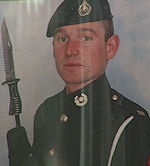MoD negligent over vehicle deaths, families claim
Exclusive: In the first of our Lost War films, three families whose sons were killed in Afghanistan tell Channel 4 News their loved ones died because their vehicles were not up to scratch.
Three families whose sons died fighting in Afghanistan claim that they would be alive today if the Ministry of Defence (MoD) had acted more quickly to provide vehicles which protected soldiers properly.
They told Channel 4 News that the vehicles in which their sons died were not designed to protect against the mines and improvised explosive devices (IEDs) which are such a big part of the war in Afghanistan, and as such they believe the MoD breached its duty of care to their children.
Their claims come just three weeks after the family of another solider, Private Lee Ellis, was told by the Court of Appeal that they could sue the MoD for negligence. Private Ellis died in 2006 when his Snatch land rover struck a roadside bomb in Iraq. The MoD’s defence of combat immunity was rejected by Lord Neuberger who said the MoD had “a duty to provide safe systems of work and safe equipment.”
I think it’s just terrible that they send these boys to fight with inadequate equipment. Sue Thwaites
Now the three families – whose sons were killed in other types of land rover to Private Ellis’s Snatch Land Rover and a reconnaissance vehicle which was a Land Rover replacement, want an independent inquiry into why their sons’ vehicles still did not protect them from mines and IEDs.
While the MoD has since upgraded its vehicles further, the families told Channel 4 News their sons need not have died if the MoD had procured mine-protected vehicles earlier than it did.
The new generation of mine-resistant ambush protected vehicles (MRAPs), have V-shaped hulls to deflect the blast away from the vehicle. The parents claim the vehicles their sons died in did not have V-shaped hulls, and as such were “inadequately protected vehicles”.
A MoD spokesperson said: “Our troops have access to a range of protected vehicles including Mastiff, Ridgeback, Husky, Wolfhound, Jackal and Foxhound, giving commanders the ability to match the most appropriate available vehicle to specific tasks based on the assessment of the operational risk.
“The MoD pays compensation where there is a legal requirement to do so.”

Trooper Jack Sadler
Ian Sadler’s son, Trooper Jack Sadler, was killed when an improvised explosive device (IED) struck his OWMIK Land Rover in 2007. Mr Sadler claims his son would still be alive today if the MoD had provided him with a better protected vehicle. The OWMIK only had blast matting in the foot wells of the vehicle.
Ian Sadler told Channel 4 News: “I want to see justice done. I’m not going to get any satisfaction out of this at all because Jack’s dead. It’s something that’s there all the time. It’s like having a piece of your psyche broken, it don’t work anymore. It’s horrible. It’s there all the time. I want to see the people responsible for this punished.”
Acknowledging the MoD is now providing better protected vehicles in Afghanistan, he claims the technology was not applied quickly enough.
“I think the British government felt it needed to stand shoulder-to-shoulder with the Americans as we should do. But they wanted to do it at the same time by keeping the purse strings tight,” he said.
Ian Sadler, who served himself in the Royal Engineers, has researched levels of protection on all MoD vehicles. He points out the latest vehicle procured – called an Ocelot, which is purpose-built with a V-shaped hull – would have given Jack a better chance of survival.

Serjeant Chris Reed
Brian Reed’s son, Serjeant Chris Reed, died in his RWMIK land rover in 2009. This vehicle is itself an upgraded version of the Land Rover Trooper Sadler died in, because it has an added blast-proof plate to the bottom of the vehicle. Brian Reed says this was not enough.
“The blast-proof matting is for small arms fire and splinters. It’s never any protection against a blast. As for the actual blast proof plate you’re talking about underneath the vehicle. It’s basically a glorified sump guard,” he said.
“In fact, my son sent an email to me saying that they ripped it off at one stage going over a large rock. If you can rip it off going over a large rock then it’s not going to do anything at all against blast protection,” he added.
Ian Sadler used the Freedom of Information Act to obtain figures for the number of fatalities by vehicle type.
The number killed in Landrovers peaked in 2006.
When deaths in Landrover replacements are added - that's protected patrol vehicles and Jackals - the number actually continues to rise, that's in large part due to significant number of men killed in the brand new Jackals.
The numbers drop off as more of the fully mine protected vehicles become available and the US Marine Corps surge into Helmand province.

Mr Reed believes that his son would still be alive if he had been in a newer vehicle, like the mine-protected Mastiff.
“Even if my son had been in a Mastiff and he had lost his life, then I could have lived with that far better than I can with him dying in the base of an RWMIK which offered him no protection whatsoever,” he said.
The frailties of the vehicles Sergeant Reed and Trooper Sadler died in – known as WMIKs – have long been known.
Lance Bombardier Ben Parkinson – the most seriously injured soldier to survive Afghanistan – was in one when he was blown up in 2006. Channel 4 News has seen the army’s board of inquiry’s report into that incident. The document draws a picture of just how unprotected these vehicles were at the time
It states: “No tests were carried out on the blast matting for the foot wells and flat areas of the vehicle”, and quotes a defence science and technology laboratory study, which says the “WMIK will be massively overmatched against close quarter improvised threats”. It suggests the EWMIK, which has enhanced armour compared to the RWMIK, is “still insufficient to guarantee protection from anti-vehicle mines”.
Brian Reed claims the Land Rover upgrades were more to do with name changes – from a Snatch land rover to an OWMIK, a RWMIK, a EWMIK – than actually enhancing protection for soldiers.
He said: “If they group the deaths under the same vehicle, a Land Rover, then 80 soldiers have lost their lives in that vehicle. That’s a different ball game.”

Marine Neil Dunstan
Sue Thwaites’ son, Marine Neil Dunstan, was killed when his Jackal – another replacement vehicle – hit a roadside bomb in 2008. The Jackal was brought in to replace the WMIKs and the MoD claim it is mine-protected and has a V-shaped hull. But experts Channel 4 News has spoken to suggest it only has V-shaped blast proof plating under the vehicle, as opposed to a V-shaped hull.
Sue Thwaites said: “The vehicles that were being used should have been mine-resistant. Although they bolted extra armour on, this vehicle was not mine-resistant. I think it’s just terrible that they send these boys to fight with inadequate equipment.
“They’re sort of fighting with one arm behind their back really. If they are to do a job, then they ought to be given the equipment to do the job. Otherwise, I’d say, a duty of care has been breached.”
Land Rovers are no longer regarded by the MoD as safe for use outside Nato bases in Afghanistan. Two years after Neil Dunstan was killed, the MoD placed an order for a better protected version of the Jackal.
But for these families, that’s just not enough.
